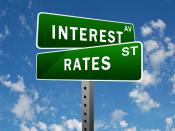Governments of countries finance many of their activities - for example public and merit goods provision and/or subsidisation - through borrowing from lenders by issuing bonds. In the UK government bonds are known as gilt edged securities and are referred to as 'gilts.' Responsibility for them is managed by the Debt Management Office (DMO) which is an executive agency of the Treasury.. They advise on debt issues and organize the auctions of gilts on behalf of HM Treasury.
As with all forms of assets gilts pay a annual yield, known as the coupon in the gilt edged market. However the coupon isn't a perfect guide to the interest rate the Government had to pay when they issued the gilt because stocks are sometimes issued at a premium or discount o their par value.
The prices of gilts are determined primarily by interest rates but are also influenced by news and technical influences.
Firstly let us examine the effect of a change in interest rates on the price of gilts. This is best explained by a theoretical case involving 3 different stocks(1). Suppose that in 2001 the DMO decided to issue 3 stocks with the following details:
Price Income Yield Redemption Yield
Short-dated 4.5% 2003 100 4.5% 4.5%
Medium -dated 4.5% 20010 100 4.5% 4.5%
Long -dated 4.5% 2025 100 4.5% 4.5%
Suppose that a year later the UK economy has began to deteriate and that there's evidence of inflation growing, and the US economy, a major importer of our goods, is slumping and investors are demanding higher yields to compensate. If the DMO wanted to issue a new gilt at this point they would have to offer a yield of, for example 6%, to persuade investors to buy. It's clear that investors wouldn't buy the 3 stocks above at a...



Interest rates
Submitting your essay more than once is a waste of the reader's time
5 out of 5 people found this comment useful.